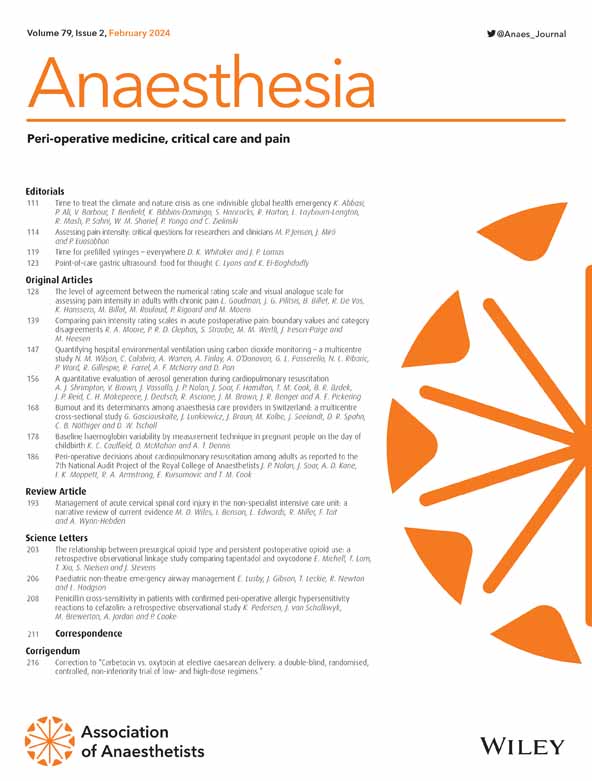Separating the signal from the noise: how mortality rate associated with hip fracture changes over time after accounting for population level mortality rates
IF 7.5
1区 医学
Q1 ANESTHESIOLOGY
引用次数: 0
从噪音中分离信号:在考虑了人口水平的死亡率后,与髋部骨折相关的死亡率是如何随时间变化的
衡量髋部骨折后的生存率如何随时间变化是很重要的,因为这是一个以患者为中心的重要结果,反映了我们为患者提供的护理。髋部骨折后30天死亡率结果由国家髋部骨折数据库(NHFD)[1]滚动公布。虽然病例组合调整死亡率对于确定医院与全国平均水平的离群值很有用,但它们不太适合确定由于提高护理标准而导致的死亡率的时间变化。病例组合调整后的死亡率没有调整普通人群死亡风险的变化,例如与COVID-19大流行相关的人群,更重要的是,没有调整死亡风险随时间逐渐下降的长期趋势。此外,30天的时间太短,无法捕捉到许多旨在提高生存率的重要干预措施的影响[2,3]。本研究的目的是对现有髋部骨折死亡率数据进行另一种分析,以区分由于更好的护理而导致的死亡率改善和由于人口死亡率波动而导致的死亡率变化。在2012年至2023年期间,所有符合NHFD纳入标准的患者都是在伦敦一家医院内确定的。通过检索电子病历和国家脊柱数据库,确定每位患者的生存状态,包括适用的死亡日期。未接受手术或生存状况无法确定的患者不包括在内。由于数量有限,65岁和95岁的患者未被研究。确定的患者根据骨折时间分为4个三年期(2012-2014年、2015-2017年、2018-2020年和2021-2023年)。每个三年期按性别和5岁年龄组分层,以便计算每个阶层1个月和12个月时观察到的死亡人数。每个阶层的预期死亡率是根据英国国家统计局公布的死亡率计算出来的。这些数据每三年发表一次,与本研究中使用的数据相匹配。每个三年期的超额死亡率以标准化死亡率(SMR)表示,采用95%置信区间的间接方法计算。SMR表示观察到的死亡与预期死亡的比率,并根据年龄、性别和骨折年份进行调整。4个三年期的基本人口统计数据是一致的(表1)。总粗死亡率为1个月时5.08%,12个月时21.12%。表1。髋部骨折术后每三年的患者特征。数值为中位数(IQR [range])或95%CI。2012-20142015-20172018-20202021-2023n = 348n = 484n = 539n = 649女性:男性比例71:2967:3371:2967:33年龄;术后标准化死亡率1个月7.92(4.70-12.52)6.47(4.00-9.88)6.54(4.10-9.91)8.30(5.71-11.65)12个月2.46(1.90-3.12)2.23(1.79-2.75)2.60(2.13-3.15)2.77(2.31-3.38)本研究显示我院2012-2023年髋部骨折相关的超额死亡率未见改善。Johnston等人在1998-2005年对苏格兰队列采用了类似的方法,报道1年绝对死亡率为30.7%,而本研究为21.1%。然而,在1998-2005年期间,普通人群经历的背景死亡风险大大高于最近的这项研究。考虑到这一点,Johnston等人报道1年的SMR为1.89,低于本文报道的任何一个三年期。这一比较表明绝对死亡率是多么具有误导性。SMR更准确地描述了两组患者髋部骨折死亡风险的变化,并描绘了一幅截然不同的图景。这是一项数量相对较少的单中心研究,需要3年的队列和5年的年龄分层。理想情况下,smr应按每年计算,患者应按单年年龄范围分层。该方法假设全国人口死亡风险准确地描述了我国当地暴露于髋部骨折的人口的背景死亡风险。这是不可能的,原因有二。首先,死亡风险存在地区差异,伦敦人口的背景死亡风险可能低于全国平均水平。其次,髋部骨折患者的合并症高于其年龄和性别匹配人群的平均水平。应该认识到这些限制,但除非在12年的研究期间发生重大的人口变化,否则其影响将随着时间的推移而保持一致。用倾向得分匹配来解决这些限制并不具有计算smr所提供的可重复性优势。本研究为追踪髋部骨折手术后超额死亡率的变化提供了一种简单的方法。 它的优点是能够比较不同基线死亡风险人群之间的死亡结果。因此,可以进行时间比较,而不会错误地将改善人群死亡率风险的既定趋势归因于临床护理的改善。进一步的努力应侧重于在多中心研究中复制这种方法。跨多个站点的更大数量将减轻上述限制。如果每年提供这些数据,以便对长期的死亡率结果进行适当监测,这将是有价值的。
本文章由计算机程序翻译,如有差异,请以英文原文为准。
求助全文
约1分钟内获得全文
求助全文
来源期刊

Anaesthesia
医学-麻醉学
CiteScore
21.20
自引率
9.30%
发文量
300
审稿时长
6 months
期刊介绍:
The official journal of the Association of Anaesthetists is Anaesthesia. It is a comprehensive international publication that covers a wide range of topics. The journal focuses on general and regional anaesthesia, as well as intensive care and pain therapy. It includes original articles that have undergone peer review, covering all aspects of these fields, including research on equipment.
 求助内容:
求助内容: 应助结果提醒方式:
应助结果提醒方式:


